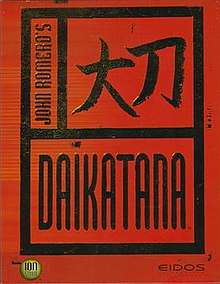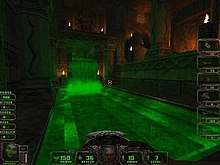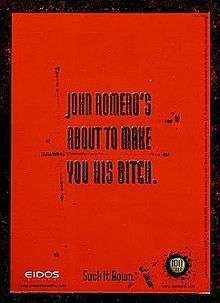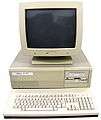Daikatana
John Romero's Daikatana is a first-person shooter video game developed by Ion Storm for Microsoft Windows and Nintendo 64, and released in 2000. The Game Boy Color game of the same name released the same year is entirely different, being a top-down action-adventure game by Japanese studio Kemco. The game is split into four episodes, each representing a different time period, and is centred around the conflict between two rival clans, the Ebihara and Mishima. During development, the game initially had the original Quake engine; however, this was switched to the Quake II engine, causing the game to be delayed. Close to release, the promotion for the game focused on the lead developers and the studio, and one notorious aspect of the promotion was a poster with the phrase "John Romero's About To Make You His Bitch". A PlayStation version had been planned but was cancelled during development.
| John Romero's Daikatana | |
|---|---|
 | |
| Developer(s) | Ion Storm |
| Publisher(s) |
|
| Producer(s) | Kelly Hoerner |
| Designer(s) | John Romero |
| Programmer(s) | Shawn C. Green |
| Artist(s) |
|
| Writer(s) | Jorge Gonzalez |
| Composer(s) |
|
| Engine | id Tech 2 |
| Platform(s) | Microsoft Windows, Nintendo 64 |
| Release | Microsoft Windows Nintendo 64 |
| Genre(s) | First-person shooter |
| Mode(s) | Single-player, multiplayer |
Upon release, it received mostly negative reviews, mostly criticising it for its outdated graphical presentation, gameplay, repeated sound effects and its poorly programmed AI companions; it also sold poorly, only selling 40,351 copies compared to the 2.5 million that was required for the game to be profitable. The game is considered by some game critics to be one of the worst video games of all time, due to issues with the game itself, its development and the way it was promoted.
Gameplay

Daikatana is composed of 24 levels (18 in the console versions) divided into four episodes, with a varying number of levels per episode. Each episode represents a different location and time period: 25th century Japan in 2455 AD, ancient Greece in 1200 BC, the Dark Ages in Norway in 560 AD, and near-future San Francisco in 2030 AD.
One element that Daikatana stressed was the important role of Hiro Miyamoto's two sidekicks, Mikiko Ebihara and Superfly Johnson. The death of either sidekick resulted in failing the level, and their assistance was required to complete certain puzzles. Due to poor AI implementation, the sidekicks, who were one of the game's selling points, became a focus of criticism.[2]
Plot
In feudal Japan, two rival clans, the Ebihara and the Mishima, are at war. The Mishima go to the swordmaster Usagi Miyamoto to craft a weapon to end the conflict: the Daikatana. However, Usagi realizes the Mishimas' dark desires and gives the Daikatana to the Ebihara; Inshiro Ebihara throws the sword into a volcano at the end of the war.
In 2455 AD, swordmaster Hiro Miyamoto is visited by a man named Dr. Toshiro Ebihara, a descendant of Inshiro who is suffering from a plague and about to die. Toshiro tells Hiro that Kage Mishima, the ruler of the planet, took over the world by stealing the Daikatana and using it to alter history. He stole the cure to a viral plague in 2030 and uses the cure to control the world's population. Mikiko Ebihara, Toshiro's daughter, has been captured when trying to steal back the Daikatana, and Hiro must rescue her and fix history.
Hiro storms the Mishima's headquarters where he rescues Mikiko as well as Superfly Johnson, the Mishima's head of security who rebelled when he grew sick of the Mishima's brutal totalitarian practices. Mikiko and Superfly join Hiro in his quest and steal the Daikatana. The Mishima encounters the trio as the trio steal the sword, wielding a second Daikatana. The Mishima sends the trio back in time to Ancient Greece. Hiro and Mikiko defeat Medusa, recharging the Daikatana as it absorbs Medusa's power. The three time jump once more, only to encounter the Mishima again and be sent through time to the Dark Ages, stranded as the Daikatana has run out of energy.
The group finds a sorcerer named Musilde who offers to recharge the Daikatana if Hiro, Superfly, and Mikiko can save his village from the black plague. To do this, the group must defeat the necromancer Nharre, reassemble the Purifier, a magical sword, and use it to restore King Gharroth's sanity so that he may use the sword to put an end to the plague. When King Gharroth recharges the Daikatana, Hiro and his allies time jump again, finally ending up in 2030, where San Francisco has fallen to gangs and martial law has been declared by the military and the Mishima.
The trio fights their way through a naval base where the Mishima is working on weapons. The ghost of Usagi enters Hiro's body and gives him full control over the Daikatana. With Usagi's knowledge and skills with the sword, Hiro slays the Mishima. One of the Daikatana disappears, as its timeline no longer exists.
Mikiko steals the remaining Daikatana and kills Superfly, revealing that the feudal Ebihara clan was just as evil as the Mishimas. She announces her intentions to use the Daikatana to restore the honor of her ancient clan and take over the world. Hiro defeats and kills Mikiko, then uses the Daikatana to fix history once and for all. The Daikatana is never found in 2455, the viral plague is cured in 2030, the Mishima never take over the world, and Hiro exiles himself to a forgotten corner of the space-time continuum, safeguarding the Daikatana to ensure that it never falls into the hands of evil.
Development
_(cropped).jpg)
Daikatana was created by John Romero, an influential developer whose resume included founding titles in the first-person shooter genre (Wolfenstein 3D, Doom, Quake) when he worked at id Software. The game was developed by Ion Storm, a company co-founded by Romero with Tom Hall in 1995 after the two left id Software.[3] The aim was for the company to create games that catered to their creative tastes without excessive publisher interference, something both Romero and Hall were tired of.[4] Daikatana was part of an initial three-game contract made between Ion Storm and expanding publisher Eidos Interactive; and the third title to be conceived at Ion Storm after Anachronox and what would become Dominion: Storm Over Gift 3.[4][5]
The game was built using the original Quake game engine; according to an early interview, Romero planned Daikatana to have unique weapon sets and 16 monsters per time period.[4] The core concept was to do something different with shooter mechanics several times within the same game.[6] Romero created the basic storyline, and named its protagonist Hiro Miyamoto in honour of Japanese game designer Shigeru Miyamoto.[7] The title is written in Japanese kanji, translating roughly to "big sword". The name comes from an item in a Dungeons & Dragons campaign played by the original members of id Software, which Romero co-founded.[8] During this early period, the team consisted of fifteen people.[9] The music was composed by a team which included Will Loconto.[10] However, during its earlier production, the team saw the Quake II engine and decided to incorporate its code. This resulted in many delays when finalising the engine. The problems with programming the new engine contributed to the game being delayed from its projected 1998 release date.[5] Romero stated prior to release that he would have chosen the Quake II engine to develop the game from the start if given the chance.[11] Romero later ascribed some problems triggered in using the technology as being due to the rivalry manufactured by the company's marketing between them and id Software.[5] Due to the delays, development of the game ran parallel to Anachronox, Dominion: Storm Over Gift 3, and eventually Deus Ex.[5][12]
Something that further impacted production was the departure of around twenty staff members from the team, who either left Ion Storm or transferred to the Austin studio.[6][7] In 1998, lead artist Bryan Pritchard left the company and was replaced by Eric Smith.[13] According to staff member Chrstian Divine, the growing negative press surrounding the company had a further detrimental effect on development. Some of the backlash eventually led to his own departure for Ion Storm's Austin studio to work on Deus Ex.[7] The most notorious incident was the public resignation of nine core team members at once, something Romero understood given the low team morale but felt it as a betrayal of trust.[5][7] The departures led to the hiring of Stevie Case as level designer and Chris Perna to polish and add to character models.[14][15] In a 1999 interview, Romero attributed the slowing of development during that period to the staff departures, but said that most of the level design and the entire score had been completed before that.[11] Problems reached the point that Eidos publishing director John Kavanagh was sent down to sort out problems surrounding it production.[16] In a later interview, Romero admitted there were many faults with the game at release, blaming the development culture and management clashes at Ion Storm, in addition to staff departures causing much of the work to be scrapped and begun over again.[5][6] Divine attributed the problems to a combination of overly carefree atmosphere, and corporate struggles about company ownership interfering with game production.[7] Only two staff members remained on the game for the entirety of its production.[6]
Promotion and release

Daikatana was revealed in 1997, forming part of the opening publicity for Ion Storm.[4] In subsequent years, the press material focused almost entirely on pushing the company name and its lead developers, something later regretted by several of its staff. This was particularly true of Romero. This consequently drew Romero away from production, leading to further difficulties.[5][7][11] Public, journalistic and commercial confidence in the project was weakened by the repeated delays to its release date.[7][12] The situation was worsened when the Dallas Observer printed a story about the internal struggles of the Austin office, which cited both undercover interviews and leaked emails. The article prompted widespread publicity surrounding the staff departures and the company's financial status.[5][12] Romero responded by calling the claims of the article "both biased and inaccurate".[12] Later, Romero felt that their marketing's attempts to push the game only made Ion Storm and its core members come off as egotistical.[5]
One advert for the game became notorious; a 1997 poster containing the phrase "John Romero's About To Make You His Bitch".[5][7] According to Mike Wilson, the advert was created by the same artist who designed the game's box art under order of their chosen advertising agency. Originally, both he and Romero thought it was funny and approved it. Romero had second thoughts soon after but was persuaded by Wilson to let it pass.[5] Speaking ten years later, Romero said while wary of the slogan at the time, he went along with it as he had a reputation for similar crass phrases. In the same interview, he noted that reactions to the poster tarnished the game's image long before release, and continued to impact his public image and career.[17] In a 2008 blog post concerning the recent activities of Wilson, Romero attributed him for the marketing tactic. This prompted a hostile exchange of public messages between the two at the time.[5][17][18]
The game was demoed at the 1999 Electronic Entertainment Expo. The demo ran at a very low frame rate, which further damaged the game's public image. Staff member Jake Hughes remembered that Romero wanted changes made which crippled the demo tech and caused the issues, while Romero states that he had already departed for E3 and the upper management insisted on the changes when he was gone.[5] On April 21, 2000, Daikatana was completed and reached gold status.[19] A tie-in comic book was drawn by Marc Silvestri[20] and released by Top Cow for Prima Games' Daikatana: Prima's Official Strategy Guide.[21] The Nintendo 64 version was first released as a Blockbuster rental exclusive by Kemco.[22] It was later released for retail on November 26, 2000.[23]
Daikatana's final patch, version 1.2, was released on September 29, 2000.[24] Following the release of Daikatana and Anachronox, Ion Storm Austin decided to close the Dallas branch office in July 2001.[5][7] In the absence of any further official support after this closure, John Romero gave the game's source code to community members, allowing them to develop additional platform ports (most notably Linux, macOS and other Unix-like systems) and bug fixes.[25]
In 2016, an unofficial patch version 1.3 was released by fans. It provides significant fixes and updates such as the ability to play without sidekicks, widescreen support, faster load times and HD texture support.[26]
Reception
Sales
Before Daikatana's release, reports indicated that Ion Storm forecast sales of 2.5 million units, a number that GameDaily called necessary for the game "to become profitable".[27] According to American market research company PC Data, a week after its release, the game ranked number ten on their charts from the week of May 28 to June 3.[28] The computer version of Daikatana sold 8,190 copies in the United States by July 21, which drew revenues of $271,982. Mark Asher of CNET Gamecenter called this performance "a disaster".[29] According to PC Data, the game's domestic sales reached 40,351 units through September 2000.[30]
Critical reviews
| Reception | |||||||||||||||||||||||||||||||||||||||||||||||||||||
|---|---|---|---|---|---|---|---|---|---|---|---|---|---|---|---|---|---|---|---|---|---|---|---|---|---|---|---|---|---|---|---|---|---|---|---|---|---|---|---|---|---|---|---|---|---|---|---|---|---|---|---|---|---|
| |||||||||||||||||||||||||||||||||||||||||||||||||||||
Jeff Lundrigan reviewed the PC version of the game for Next Generation, rating it two stars out of five, and stated that "This isn't the worst game you'll ever play, but there's precious little fun either. Two years out of its time, Daikatana is notable mostly for its mediocrity."[43]
The Nintendo 64 version received "unfavorable" reviews, according to the review aggregation website GameRankings.[46][47]
Daikatana was delayed multiple times from its conception in early 1997 to its eventual release in 2000. By this time, numerous games based on more advanced graphics technology, such as Quake III Arena and Unreal Tournament, had been released, causing Daikatana to lag technologically in the market with its dated game engine. The gameplay had many aspects that were widely disliked by players, such as an artificially limited number of saves per level and the presence of computer-controlled "sidekicks" who were more of an impediment to the player. As a result, Daikatana garnered mixed reception from reviewers and players. The earliest review of the Nintendo 64 version came from Nintendo Power, which gave it a score of 5.6 out of 10, even though the game itself was not released until five months later.[44] Entertainment Weekly gave it a "D", calling the game "a disaster of Waterworld-ian proportions."[48]
In 2001, Computer Gaming World voted it as the worst game of 2000.[49]
Retrospective analysis
Since its release, the game has been called one of the worst video games of all time.[50][51][52] GameTrailers ranked the game the second biggest gaming disappointment of the decade (the 2000s), citing the game's terrible AI for friend and foe alike, pushed-back release dates, controversial magazine ad, and gossip-worthy internal drama (among other things) as "the embodiment of game's industry hubris."[53]
The game critic Ben "Yahtzee" Croshaw, on a retrospective episode of Zero Punctuation, also citing the development delays and the magazine ad, named Daikatana "one of the most notorious disappointments in the entire history of first-person shooters", comparing the game to Duke Nukem Forever.[54]
Game Boy Color version
The Game Boy Color version of Daikatana was only released in Europe; Kemco decided against the North American and Japanese release due to the poor reputation of the Daikatana brand.[55] This version's gameplay differs greatly from the N64 and PC versions: at Romero's request, the title was adapted to the platform as a top-down dungeon crawler, in the style of early Zelda games such as the NES original and The Legend of Zelda: Link's Awakening.[55][56] In 2004, Romero released the ROM images for the Game Boy Color game on his website, for use with emulators.[55][57] Frank Provo for GameSpot gave the game a seven out of ten.[56]
See also



References
Citations
- "John Romero's Daikatana will be coming to stores Monday!". Eidos Interactive. May 19, 2000. Archived from the original on October 12, 2003. Retrieved October 15, 2003.
- Reparaz, Mikel (March 21, 2007). "The Top 7... PR disasters (Page 5)". GamesRadar. Retrieved April 27, 2014.
Worse, the game's biggest "innovation" – sidekicks whom you needed to protect – turned out to be its biggest liability, as their computer-controlled brains would diligently do whatever it took to get them killed.
- Walter, Barbara (October 31, 1997). "An Interview with Ion Storm's Mike Wilson". Gamasutra. Archived from the original on November 14, 2013. Retrieved November 22, 2019.
- "Does John Romero Still Enjoy Shooting People?". Next Generation. No. 30. Imagine Media. June 1997. p. 12.
- Lane, Rick (February 16, 2018). "The History of Ion Storm". PC Gamer. Archived from the original on October 1, 2019. Retrieved November 22, 2019.
- "Interview: John Romero". Computer and Video Games. March 17, 2006. Archived from the original on April 17, 2010. Retrieved November 22, 2019.
- Divine, Christian (January 2, 2002). "A hardcore elegy for Ion Storm". Salon. Archived from the original on October 15, 2012. Retrieved November 22, 2019.
- Kushner 2003.
- "John Romero Interview". Planet Daikatana. March 20, 1997. Archived from the original on September 4, 2000.
- Ocampo, Jason (September 8, 1998). "New screenshots of ION Storm's 3D shooter". Computer Games Online. Archived from the original on December 1, 2002. Retrieved November 22, 2019.
- "Riding the Storm". Computer Games Online. January 20, 1999. Archived from the original on December 16, 2002. Retrieved November 22, 2019.
- Staff (January 1999). "GameDAILY Interviews ION Storm's John Romero". GameDaily. Archived from the original on April 25, 2001.
- "Eric Smith Named Daikatana Lead Artist". Ion Storm. October 23, 1998. Archived from the original on December 8, 2001. Retrieved November 22, 2019.
- Law, Caryn. "Women of Gaming; Stevie "Killcreek" Case--Ion Storm". GameSpy. Archived from the original on February 24, 2011. Retrieved November 22, 2019.
- Kelly, Ryan. "The Art of Gaming 2: Volume 7". GameSpy. Archived from the original on October 4, 2008. Retrieved November 22, 2019.
- Fudge, James (March 21, 1999). "Eidos Eyeing Ion?". Computer Games Online. Archived from the original on July 4, 2003. Retrieved November 22, 2019.
- Ashcraft, Brian (May 18, 2010). "John Romero Is So Sorry About Trying To Make You His Bitch". Kotaku. Archived from the original on May 29, 2019. Retrieved November 22, 2019.
- Purchese, Robert (January 21, 2008). "Romero and Wilson spat gets dirty". Eurogamer. Archived from the original on June 5, 2016. Retrieved November 22, 2019.
- Ajami, Amer (April 21, 2000). "Daikatana Is Gold". GameSpot. Archived from the original on February 8, 2001.
- "The cover of the Daikatana comic by Mark Silvestri. - ROME.RO Photos - John Romero". Romero.smugmug.com. Retrieved May 5, 2015.
- "Daikatana by Prima Game Secrets | 9780761514831 | Paperback | Barnes & Noble". Barnesandnoble.com. January 3, 2000. Retrieved May 5, 2015.
- GameSpot Staff (August 2, 2000). "Rental Only Daikatana". GameSpot. Retrieved October 24, 2019.
- GameSpot Staff (October 28, 2003). "Daikatana Finally Ships for the Nintendo 64". GameSpot. Retrieved October 24, 2019.
- "New Daikatana US and UK Patches". Daikatana.com. September 29, 2000. Archived from the original on March 1, 2002. Retrieved December 12, 2015.
- LeBreton, Jean Paul; Romero, John (January 20, 2015). "Devs Play" S01E05 - Doom (Part 8 - Map 6 Central Processing) 60fps [8/10]. YouTube. Double Fine Productions. Event occurs at 5:56. Retrieved December 12, 2015.
- Winkie, Luke (February 16, 2017). "Meet the superfans who spent a decade bringing Daikatana back to life". PC Gamer. Retrieved July 26, 2020.
- Staff (January 1999). "GameDAILY Interviews ION Storm's John Romero". GameDaily. Archived from the original on April 25, 2001. Retrieved July 14, 2019.
- GameSpot Staff (May 17, 2006). "Daikatana Steps Up". GameSpot. Retrieved October 24, 2019.
- Asher, Mark (July 21, 2000). "Game Spin: An Irrational Superhero Game". CNET Gamecenter. Archived from the original on August 16, 2000. Retrieved July 14, 2019.
- Staff (January 2001). "Wolfenstein Story: The Patch". Computer Gaming World (198): 33.
- Edge Staff (July 2000). "Daikatana Review (PC)". Edge (86). Archived from the original on April 27, 2014. Retrieved April 27, 2014.
- "Daikatana (N64)". Electronic Gaming Monthly. 2000.
- Bramwell, Tom (July 1, 2000). "Daikatana (PC)". Eurogamer. Retrieved April 27, 2014.
- Howarth, Robert (May 26, 2000). "REVIEW for Daikatana (PC)". GameFan. Archived from the original on June 22, 2000. Retrieved April 27, 2014.
- Wight, Brian (June 1, 2000). "Daikatana Review for PC on GamePro.com". GamePro. Archived from the original on January 24, 2005. Retrieved April 27, 2014.
- Johnny B. (May 2000). "Daikatana Review (PC)". Game Revolution. Retrieved April 27, 2014.
- Satterfield, Shane (August 7, 2000). "Daikatana Review (N64)". GameSpot. Retrieved April 27, 2014.
- Wolpaw, Erik (June 1, 2000). "Daikatana Review (PC)". GameSpot. Retrieved April 27, 2014.
- Timperley, Nate "Lokust" (June 12, 2000). "Daikatana (PC)". GameSpy. Archived from the original on September 3, 2004. Retrieved April 27, 2014.
- Lafferty, Michael (May 29, 2000). "Daikatana - PC - Review". GameZone. Archived from the original on February 9, 2009. Retrieved April 27, 2014.
- Casamassina, Matt (November 21, 2000). "Daikatana (N64)". IGN. Retrieved April 27, 2014.
- Lopez, Vincent (June 1, 2000). "Daikatana (PC)". IGN. Retrieved April 27, 2014.
- Lundrigan, Jeff (August 2000). "Finals". Next Generation. Vol. 3 no. 8. Imagine Media. p. 95.
- "Daikatana (N64)". Nintendo Power. 130. March 2000.
- Williamson, Colin (August 2000). "Daikatana". PC Gamer. Archived from the original on August 18, 2000. Retrieved April 27, 2014.
- "John Romero's Daikatana for Nintendo 64". GameRankings. Retrieved April 27, 2014.
- "John Romero's Daikatana for PC". GameRankings. Retrieved April 27, 2014.
- Brooks, Mark (June 16, 2000). "Daikatana Review". Entertainment Weekly (545). Retrieved April 27, 2014.
- CGW Staff (April 2001). "Computer Gaming World Game of the Year Awards" (PDF). Computer Gaming World. No. 201. p. 83.
- Stuart, Keith; Kelly, Andy; Parkin, Simon; Cobbett, Richard (October 15, 2015). "The 30 worst video games of all time – part one". The Guardian. Retrieved October 24, 2019.
- Townsend, Emru (October 23, 2006). "The 10 Worst Games of All Time". PC World. Retrieved October 24, 2019.
- GamesRadar Staff. "The 100 worst games of all time". GamesRadar. Archived from the original on March 19, 2016. Retrieved May 5, 2015.
- GameTrailers, Top 10 Disappointments Of The Decade Archived June 14, 2012, at the Wayback Machine
- Croshaw, Ben (September 3, 2014). "Daikatana - John Romero's B****". Escapist Magazine. Retrieved October 27, 2019.
- Romero, John. "//ROME.RO - 2000: Daikatana". Archived from the original on September 2, 2014. Retrieved July 1, 2014.
- Provo, Frank (October 10, 2000). "John Romero's Daikatana Review". GameSpot. CBS Interactive. Retrieved June 30, 2014.
- Sharkey, Scott (December 13, 2004). "Freeloader: Daikatana". 1UP.com. Ziff Davis. Archived from the original on June 4, 2015. Retrieved July 4, 2014.
Bibliography
- Kushner, David (2003). Masters of Doom. Random House. ISBN 0-8129-7215-5.
External links
- Official website
- Daikatana at MobyGames
- "From 'Doom' to Gloom: The Story of a Video Game Flop", NPR Morning Edition story on Romero, part of a series of other famous debacles
- Knee Deep in a Dream: The Story of Daikatana, a GameSpot series of behind-the-scenes articles on Romero and his work on Daikatana